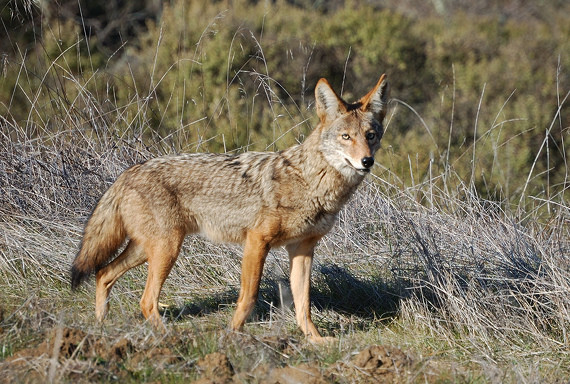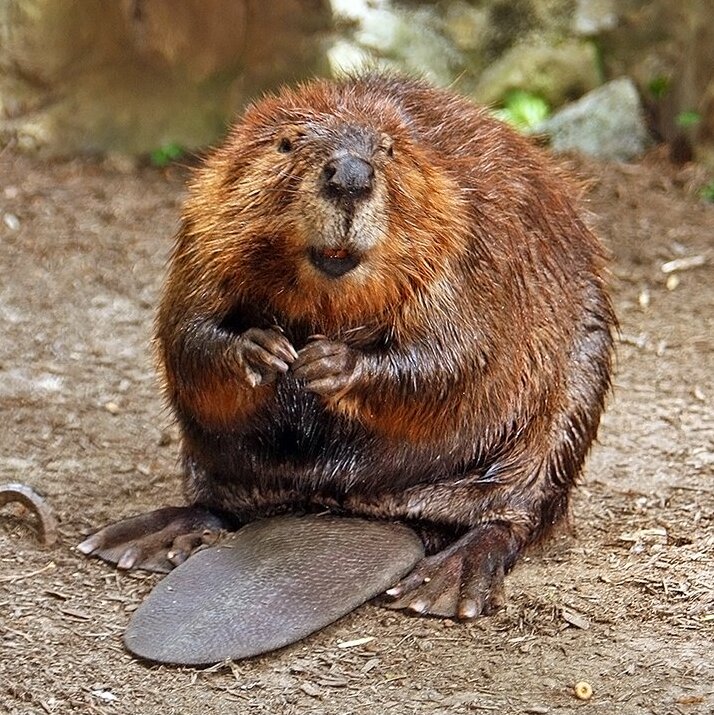Post by dinosauria101 on Oct 21, 2019 20:06:52 GMT 5
Coyote - Canis latrans
The coyote (Canis latrans), also known as the American jackal or the prairie wolf, is a species of canine found throughout North and Central America, ranging from Panama in the south, north through Mexico, the United States and Canada. It occurs as far north as Alaska and all but the northernmost portions of Canada. The color of the coyote's pelt varies from grayish-brown to yellowish-gray on the upper parts, while the throat and belly tend to have a buff or white color. The forelegs, sides of the head, muzzle and paws are reddish-brown. The back has tawny-colored underfur and long, black-tipped guard hairs that form a black dorsal stripe and a dark cross on the shoulder area. The black-tipped tail has a scent gland located on its dorsal base. Coyotes shed once a year, beginning in May with light hair loss, ending in July after heavy shedding. The ears are proportionately large in relation to the head, while the feet are relatively small in relation to the rest of the body. Certain experts have noted the shape of a domestic dog's brain case is closer to the coyote's in shape than that of a wolf's. Mountain-dwelling coyotes tend to be dark-furred, while desert coyotes tend to be more light brown in color. Coyotes typically grow to 30–34 in (76–86 cm) in length, not counting a tail of 12–16 in (30–41 cm), stand about 23–26 in (58–66 cm) at the shoulder and, on average, weigh from 15–46 lb (6.8–21 kg). Northern coyotes are typically larger than southern subspecies, with the largest coyotes on record weighing 74.75 pounds (33.91 kg) and measuring 1.75 m (5.7 ft) in total length.

www.thedigitel.com/sites/default/files/styles/large/public/field/story/image/20100630-coyot_0.jpg?itok=8weMJxaR
North American Beaver - Castor canadensis
This beaver is the largest rodent in North America and competes with its Eurasian counterpart, the European beaver, for being the second-largest in the world, both following the South American capybara. Adults usually weigh from 11 to 32 kg (24 to 71 lb), with 20 kg (44 lb) being typical. The head-and-body length is 74–90 cm (29–35 in), with the tail adding a further 20–35 cm (7.9–13.8 in). Very old individuals can exceptionally exceed normal sizes, weighing more than 40 kg (88 lb) or even as much as 50 kg (110 lb).

Credit to Wikipedia
The coyote (Canis latrans), also known as the American jackal or the prairie wolf, is a species of canine found throughout North and Central America, ranging from Panama in the south, north through Mexico, the United States and Canada. It occurs as far north as Alaska and all but the northernmost portions of Canada. The color of the coyote's pelt varies from grayish-brown to yellowish-gray on the upper parts, while the throat and belly tend to have a buff or white color. The forelegs, sides of the head, muzzle and paws are reddish-brown. The back has tawny-colored underfur and long, black-tipped guard hairs that form a black dorsal stripe and a dark cross on the shoulder area. The black-tipped tail has a scent gland located on its dorsal base. Coyotes shed once a year, beginning in May with light hair loss, ending in July after heavy shedding. The ears are proportionately large in relation to the head, while the feet are relatively small in relation to the rest of the body. Certain experts have noted the shape of a domestic dog's brain case is closer to the coyote's in shape than that of a wolf's. Mountain-dwelling coyotes tend to be dark-furred, while desert coyotes tend to be more light brown in color. Coyotes typically grow to 30–34 in (76–86 cm) in length, not counting a tail of 12–16 in (30–41 cm), stand about 23–26 in (58–66 cm) at the shoulder and, on average, weigh from 15–46 lb (6.8–21 kg). Northern coyotes are typically larger than southern subspecies, with the largest coyotes on record weighing 74.75 pounds (33.91 kg) and measuring 1.75 m (5.7 ft) in total length.

www.thedigitel.com/sites/default/files/styles/large/public/field/story/image/20100630-coyot_0.jpg?itok=8weMJxaR
North American Beaver - Castor canadensis
This beaver is the largest rodent in North America and competes with its Eurasian counterpart, the European beaver, for being the second-largest in the world, both following the South American capybara. Adults usually weigh from 11 to 32 kg (24 to 71 lb), with 20 kg (44 lb) being typical. The head-and-body length is 74–90 cm (29–35 in), with the tail adding a further 20–35 cm (7.9–13.8 in). Very old individuals can exceptionally exceed normal sizes, weighing more than 40 kg (88 lb) or even as much as 50 kg (110 lb).

Credit to Wikipedia


